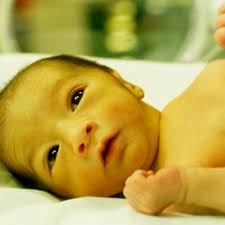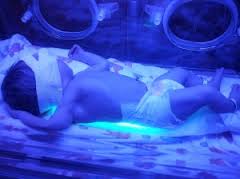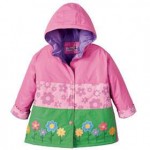What are the Symptoms of Jaundice in Newborn Baby?
December 11, 2014 by admin
Filed under Baby Problems
 Most babies are sent home after 1 or 2 days of birth, parents will have to watch their new born baby for any signs of jaundice.
Most babies are sent home after 1 or 2 days of birth, parents will have to watch their new born baby for any signs of jaundice.
Symptoms of jaundice:
Jaundice first appears on the babies face and head. As the level of bilirubin increases in the blood, the body will start showing on the body and further high levels are indicated by coloration on the palms of the hand and soles of the feet.
Testing for jaundice
Simple test that can be done at home is to press your finger tip on the tip of your child’s nose or forehead. After you lift your finger if you observe the skin is white there is no jaundice. But if you see yellowish color, consult your doctor immediately.
Blood test for jaundice
Blood test is recommended to identify the level of bilirubin and the treatment to be followed thereafter based on the blood test results and the baby’s health condition.
Serum Bilirubin values
Since 97% of term babies have serum bilirubin values <13 mg/dl, all infants with a serum bilirubin level >13 mg/dl require a minimum work up.
Causes of jaundice
Excess bilirubin (hyperbilirubinemia) is the main cause of jaundice. Bilirubin is responsible for the yellow color of jaundice, it is a normal part of the pigment released from the breakdown of “used” red blood cells.
Normally, the liver filters bilirubin from the bloodstream and releases it into the intestinal tract. A newborn’s immature liver often can’t remove bilirubin quickly enough, causing an excess of bilirubin. Jaundice due to these normal newborn conditions is called physiologic jaundice, and it typically appears on the second or third day of life.
Treatment for jaundice
Most babies who are well and healthy need not undergo treatment. As the liver matures, it will break the bilirubin into other chemicals which can be passed out through the gut.
 However Phototherapy (or light therapy) is recommended for babies whose level is getting higher. Light energy helps change the bilirubin that is just under the skin into a different chemical which is more easily passed out of the baby’s body (excreted). Babies may need phototherapy mandatorily for 48 hrs with breastfeeding the baby every 2 hrs to remove excess bilirubin from the body thru’ urine or stool. Phototherapy is safe and effective. The process followed is:
However Phototherapy (or light therapy) is recommended for babies whose level is getting higher. Light energy helps change the bilirubin that is just under the skin into a different chemical which is more easily passed out of the baby’s body (excreted). Babies may need phototherapy mandatorily for 48 hrs with breastfeeding the baby every 2 hrs to remove excess bilirubin from the body thru’ urine or stool. Phototherapy is safe and effective. The process followed is:
- Babies will be placed in a warm covered cot. They may be able to stay in their mother’s room or they may need to be moved to the ward nursery.
- They will have eye shields placed over their eyes.
- They will be nursed naked so that the maximum amount of light can fall on their skin.
- More number of feeds while the baby is having phototherapy.
- You will be encouraged to continue to care for your baby as much as possible.
- Blood tests are usually done daily to work out if your baby still needs phototherapy.
Examination for jaundice
Your baby should be examined for jaundice between the third and seventh day after birth, when bilirubin levels usually show peaks. If your baby is discharged earlier than 72 hours following birth, make a follow-up appointment to look for jaundice within two days of discharge.
Consult a doctor when you see the following symptoms:
- Your baby’s skin becomes more yellow
- Your baby’s skin looks yellow on the abdomen, arms or legs
- The whites of your baby’s eyes look yellow
- Your baby looks less energetic or sick or is difficult to awaken
- Your baby makes high-pitched cries
- Your baby isn’t gaining weight or is feeding poorly
- Your baby develops any other signs or symptoms that concern you
Jaundice lasts more than three weeks. After you complete phototherapy you can continue sunlight therapy. Take the baby to indirect sunlight early in the morning. The sun rays is also good to reduce the color for the baby.
Parents should not panic. Be alert and identify symptoms at the early stage. Do follow-up visits to the hospital after birth for routine checks.
Happy parenting!
Please add a comment and, if you like the post, feel free to share it with your friends. You can also visit our Facebook page and Google plus page for more insight.
Also read:
How to Treat Jaundice in New Born Baby
What to feed when my child has watery motions – Diarrhea
Umbilical cord care: Basics for a New mom
Vaccines for your baby – Immunization schedule
What are the Soft Spots on my Newborn Baby’s head?
Health tips to Protect baby in Rainy season
 Rainy season brings in nostalgic memories of our childhood days. The fun we had in the rain and how our parents warned us not to get wet again. They ensured we carried our raincoats, umbrellas always to avoid getting wet and falling sick. Dad always ensured the nets were tucked to prevent mosquito bites and associated illness.
Rainy season brings in nostalgic memories of our childhood days. The fun we had in the rain and how our parents warned us not to get wet again. They ensured we carried our raincoats, umbrellas always to avoid getting wet and falling sick. Dad always ensured the nets were tucked to prevent mosquito bites and associated illness.
Rainy season also reminds us of several crawling bugs and insects. There is greenery and colorful flowers all over. This is the time when planting takes place in the garden. Common sight of vendors with clay pots and fresh plants in the hand pulled trolleys.
With the arrival of monsoon many unfavorable diseases also set in. Diseases like jaundice, typhoid, cholera and other gastrointestinal infections also develop during this time. Common cold and cough among kids and elders is a common sight during rainy season. Babies are the ones who are prone to these diseases as the immunity is low and they are also much more exposed to the microorganisms than adults.
Following are some of the health tips which can protect the health of child during the rainy season.
- Children are highly prone to infections during rainy seasons. These infections are caused mainly due to fungal and bacterial infections. During rainy season these microorganisms get favorable environment to grow so proper care is required for the small babies. Ensure to bathe your little one at least once a day to keep her healthy. After the bath make sure that you wipe your child’s body with a cotton absorbent towel.
- Restrict your child from having outside food especially the ones sold by roadside vendors. This season is odd as it attracts infections due to improper hygiene conditions of the surroundings.
- Water should be filtered and then consumed. For small babies boil and cool water and then ensure storage is also maintained. Special care has to be taken for the water intake. Avoid outside water, carry a bottle of water when you plan going out with the baby.
- Make sure the kids do not play in stagnant and polluted water as it may lead to skin infections and other illnesses too.
- Give your child light and easy to digest food during monsoons. Basic reason is that the digestive system is weak during this time of the year and spicy/ oily foods can lead to digestion problems.
- Wash your hands thoroughly using a sanitizer before handling the food, feeding the baby. Make sure that your child is washing their hands before the consumption of food.
- Flies will be high in the external environment therefore make sure that all cooked food is covered so that the flies and other insects do not infect it.
- Avoid raw foods and always serve the kids freshly made food. Soups, stews and stir fried or baked vegetables are the good options to use during these seasons. If food is refrigerated ensure thawing and properly heating prior to serving.
- Nails are a major source of bacterial infection. Therefore trim nails on time and avoid the habit of nail biting in children; this may give rise to the infectious diseases.
- Ensure baby’s clothes are dried sufficiently. Damp clothes also lead to skin infections. The sunlight will be scanty during rainy season and it may not be possible to dry all clothes in the sun. Make sure to iron them.
- Make sure baby is covered well when you plan to take her out in unavoidable circumstances.

- Diseases like malaria, dengue are very common during this season. So wearing the full body clothes can help you to protect the child from these problems.
- Usage of mosquito net is mandatory, this will keep away from malaria, dengue and other allergies.
- Wipe floor at least twice a day with a germ free solution. Avoid strong chemicals and disinfectants at home.
- Ensure footwear is cleaned timely and removed at the entry to avoid carrying germs into the house.
Keep your premises clean and hygienic so that the infectious organisms do not harm you and your family.
You may also like:









